Chain pickerel are opportunistic predators that’ll eat almost anything they can catch, with their diet primarily consisting of small fish like minnows, yellow perch, and golden shiners. You’ll also find them consuming crayfish, frogs, insects, and occasionally small mammals, with larger pickerel even practicing cannibalism on smaller individuals. These ambush hunters use explosive strikes from vegetation cover, adjusting their prey selection based on size, season, and habitat availability to maximize their hunting success.
TLDR
- Chain pickerel are opportunistic predators that primarily eat small fish like minnows, yellow perch, and golden shiners.
- Their diet includes crayfish (found in 42% of stomachs), frogs, insects, and occasionally small mammals or other pickerel.
- They use ambush hunting tactics, remaining motionless near vegetation until prey comes within explosive striking distance.
- Feeding behavior changes seasonally with water temperature, peaking between 75°F-80°F with varied prey selection throughout the year.
- Younger pickerel focus more on invertebrates while adults target larger fish species like sunfish and threadfin shad.
Primary Prey Species and Diet Composition
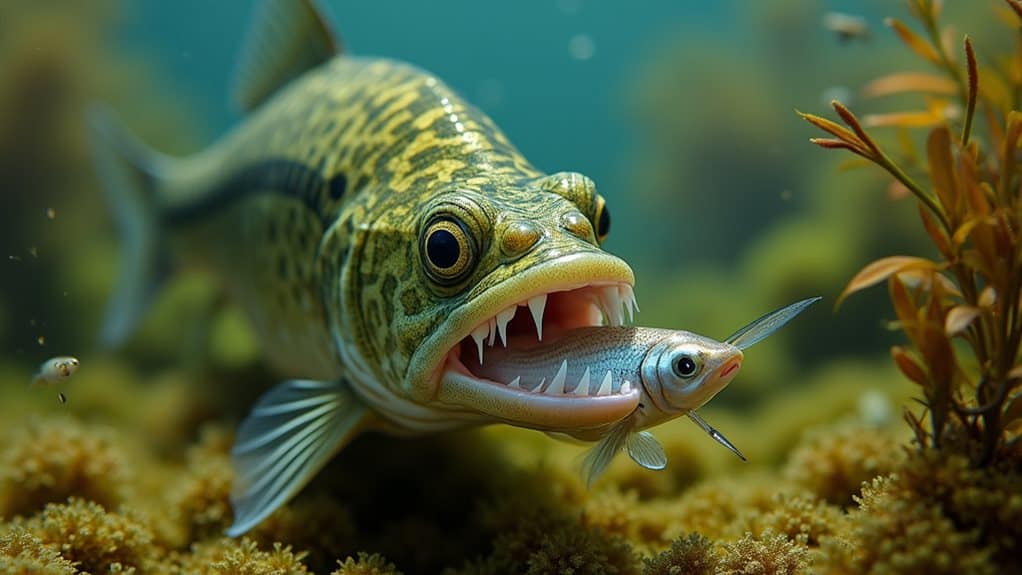
Chain pickerel are opportunistic predators with a diverse diet that changes based on their size, habitat, and seasonal prey availability.
You’ll find they primarily target small fish like minnows, yellow perch, and golden shiners, which suit their narrow gullet perfectly. During kayak fishing trips, it’s essential to know that they may also be attracted to artificial lures that mimic their natural prey.
They’ll also consume crayfish, frogs, insects, and occasionally small mammals, adapting their feeding strategy to whatever’s most abundant locally. These solitary fish rely heavily on visual cues to locate prey and initiate their feeding attacks.
Ambush Hunting Tactics and Feeding Behavior
Unlike pursuit predators that chase down their prey in open water, these fish have evolved into skillful ambush hunters that rely entirely on stealth, positioning, and explosive strikes. You’ll find chain pickerel holding motionless near dense weed beds, submerged logs, and dock pilings, where they remain almost invisible until prey ventures within striking distance, then attack with lightning-fast bursts. Their sharp teeth are perfectly designed for gripping slippery prey during these sudden ambush attacks. Bowfishing techniques can similarly rely on stealth and precision when targeting fish in their natural habitats.
Fish as the Main Food Source
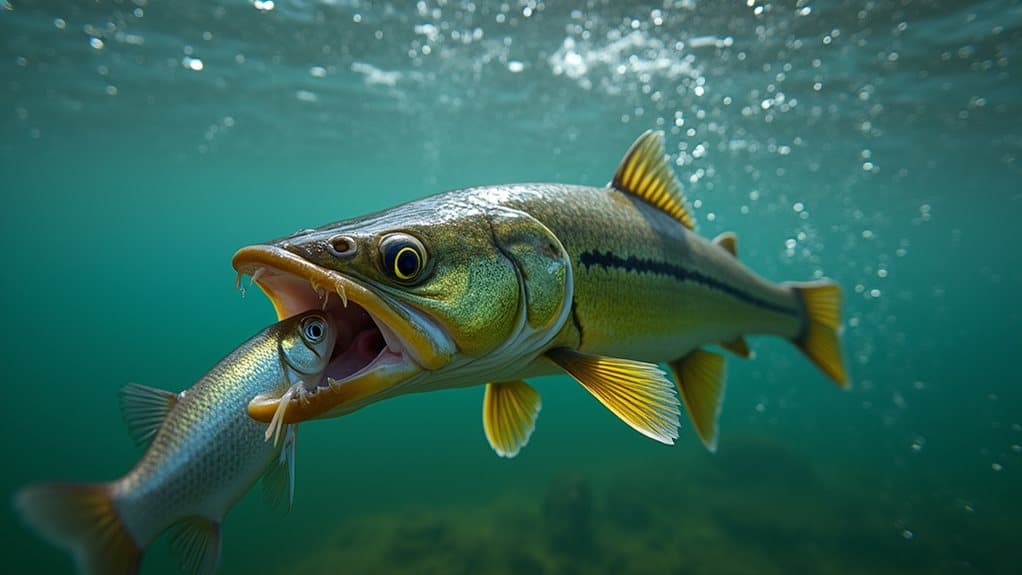
If you’re wondering what makes up the bulk of a chain pickerel’s diet, fish serve as their primary food source once they reach adulthood.
You’ll find these predators targeting small species like threadfin shad, sunfish, shiners, and minnows that share their weedy, vegetated habitats.
As pickerel grow larger, they’ll shift their prey selection to match their increasing size, moving from tiny fish as juveniles to progressively bigger species that can fit into their expandable mouths. Additionally, the competitiveness of fishing can often influence the types of fish targeted by anglers, including chain pickerel.
Primary Fish Prey Species
As opportunistic predators that dominate freshwater ecosystems, chain pickerel rely heavily on fish as their primary food source throughout their lives.
You’ll find they target diverse species including bluefin killifish, centrarchids like Lepomis, and golden topminnow.
Smaller pickerel prefer mosquitofish and bluespotted sunfish, while larger individuals hunt bigger prey, sometimes exhibiting cannibalism by consuming smaller pickerel.
Size-Based Prey Selection
When chain pickerel hunt for fish, they don’t simply grab whatever swims by—they’re remarkably selective about prey size, making calculated choices that maximize their energy return.
Larger prey provide greater energy rewards relative to capture effort, and they’re more visually conspicuous from greater distances.
You’ll notice pickerel actively select specific sizes rather than feeding randomly on available fish.
Invertebrates in the Chain Pickerel Diet
While fish dominate the diet of larger chain pickerel, you’ll find that invertebrates play a vital role throughout their lives, particularly during their younger stages.
Crayfish stand out as the most significant invertebrate prey, appearing in studies as a consistent food source that remains important even as pickerel grow larger.
You should also know that various insects and small crustaceans contribute substantially to their diet, especially when the fish are under four inches long and developing their hunting skills. Additionally, young pickerel often rely on smaller prey items similar to those found in the diets of species like flounder, which also include invertebrates during their early growth stages.
Crayfish as Primary Invertebrates
Although chain pickerel are known primarily as fish-eaters, crayfish represent the most significant invertebrate component of their diet throughout their lives.
You’ll find crayfish in approximately 42% of pickerel stomachs, appearing consistently from juvenile to adult stages.
These crustaceans provide essential nutrition during growth periods and serve as reliable fallback prey when fish become scarce seasonally.
Insects and Small Crustaceans
Beyond crayfish, chain pickerel rely heavily on insects and small crustaceans to round out their invertebrate diet, particularly during their younger stages.
You’ll find them consuming aquatic insect larvae, mayflies, dragonflies, amphipods, copepods, and freshwater shrimp.
These smaller prey items provide essential proteins for growth when fish aren’t readily available, especially in vegetation-rich shallow waters.
Vertebrate Prey Beyond Fish
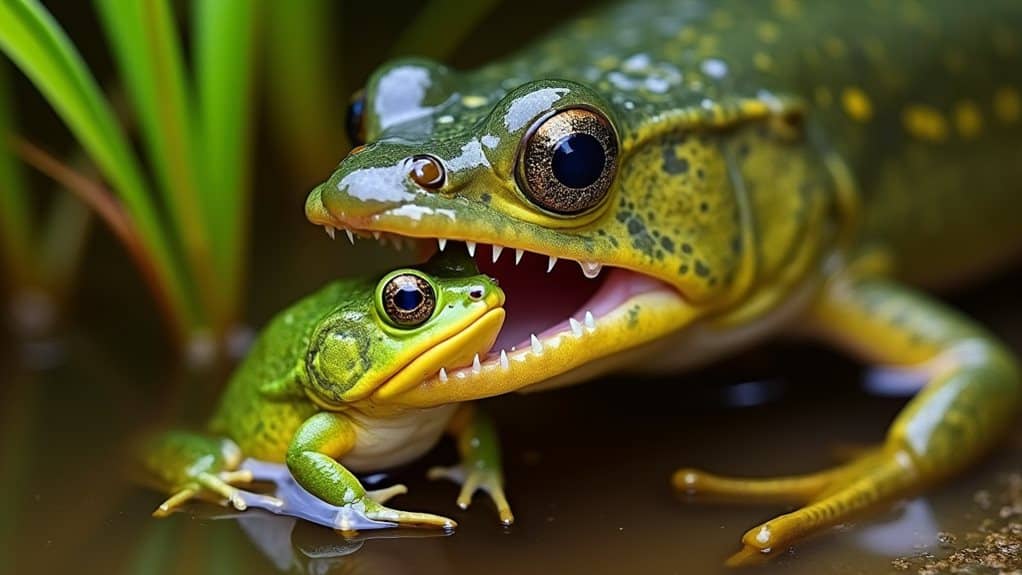
Chain pickerel demonstrate extraordinary versatility as predators by actively hunting various vertebrates that extend well beyond their typical fish-based diet.
You’ll find them ambushing frogs near aquatic vegetation, capturing small snakes at water edges, and occasionally taking rodents swimming near shallow areas.
They’ll even prey on young water birds, tadpoles, and juvenile turtles when opportunities arise.
Cannibalistic Behavior and Opportunistic Feeding
When food becomes scarce or opportunity presents itself, these aggressive predators won’t hesitate to turn on their own kind, displaying extraordinary cannibalistic tendencies that reveal just how opportunistic their feeding behavior truly is.
Larger chain pickerel regularly prey on smaller juveniles, while young fish avoid this fate by hiding motionless in mud and vegetation, blending seamlessly with their surroundings.
How Age and Size Affect Diet Preferences
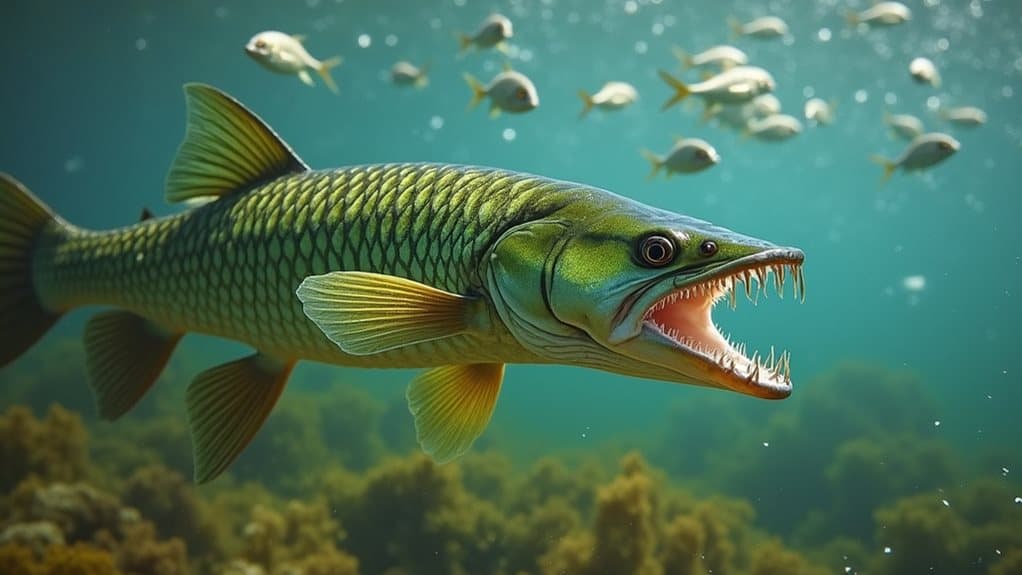
As chain pickerel mature from juveniles to adults, their dietary preferences undergo a dramatic alteration that reflects both their growing size and changing capabilities as predators.
Young pickerel under 7-9 inches primarily consume aquatic insects, crustaceans, and small invertebrates.
Once they reach this critical size threshold, they’ll shift to mainly eating fish like yellow perch, sunfishes, and minnows.
Seasonal Changes in Feeding Patterns
Understanding chain pickerel feeding patterns throughout the year requires recognizing how water temperature directly influences their activity levels and hunting behavior.
You’ll notice that these predators become increasingly aggressive as temperatures rise toward spawning season, then shift their tactics during summer’s heat before ramping up feeding again in fall.
The availability of their preferred prey also fluctuates dramatically with the seasons, as baitfish, insects, and other food sources move between shallow and deep waters in response to changing conditions.
Temperature-Driven Activity Patterns
Water temperature acts as the primary driver behind chain pickerel behavior, dictating everything from their feeding intensity to their preferred hunting locations throughout the year.
You’ll find these fish most active between 40°F and 80°F, with ideal feeding occurring at 75°F to 80°F.
They’ll migrate between shallow and deep waters, following temperature changes seasonally.
Prey Availability Fluctuations
While water temperature drives chain pickerel activity levels, the seasonal availability of prey fundamentally shapes their feeding patterns throughout the year.
You’ll notice they target larger prey during pre-spawn feeding binges, then shift to abundant forage fish in shallow post-spawn areas.
Summer brings diverse opportunities with frogs, insects, and small mammals, while winter concentrates feeding around remaining active prey.
Habitat Influence on Food Availability
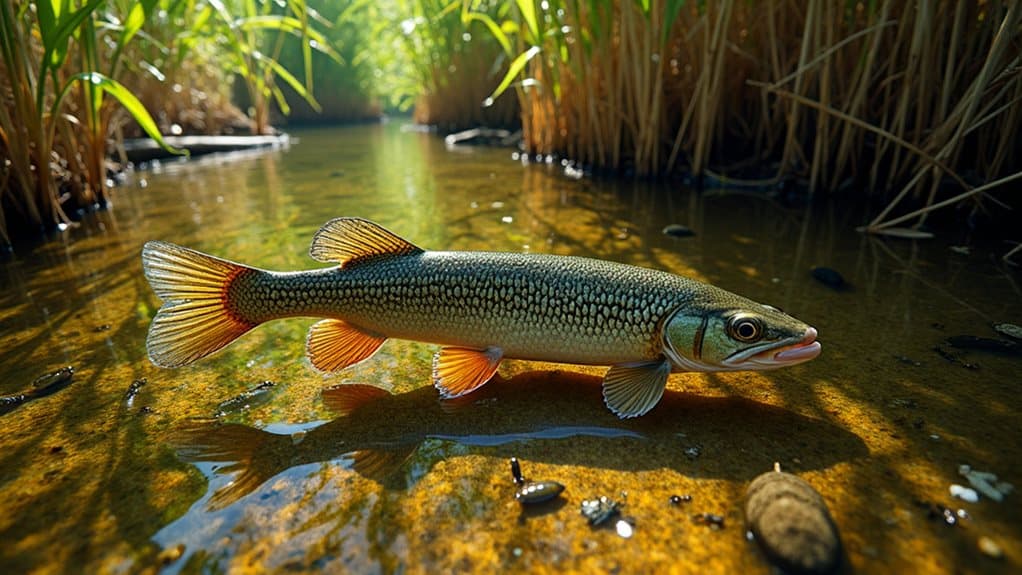
Since chain pickerel rely heavily on ambush tactics to capture their prey, the specific habitat they choose directly determines what food sources they’ll encounter and how successfully they can hunt.
Dense aquatic vegetation and submerged structures like logs create ideal hunting grounds by supporting abundant prey populations while providing visual concealment for effective ambush predation.
Ecological Role as Top Freshwater Predator
As apex predators in freshwater ecosystems, chain pickerel occupy an essential position at the top of the food web, where they serve as keystone species that greatly influence the structure and interactions of aquatic communities.
You’ll find they regulate prey populations through direct predation, creating cascading effects that impact community structure, competitive balance among species, and overall ecosystem functioning.
Final Note
Understanding what chain pickerel eat helps you appreciate their role as versatile freshwater predators. You’ve learned they’re opportunistic hunters who adapt their diet based on size, season, and habitat availability. From small invertebrates to substantial fish prey, they’ll consume whatever offers the best energy return. Whether you’re an angler targeting them or simply curious about aquatic ecosystems, recognizing their diverse feeding habits enhances your connection to these fascinating ambush predators.




